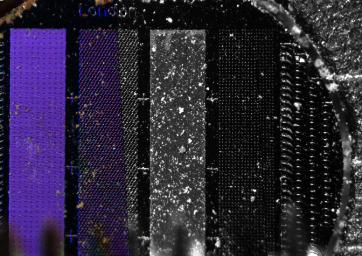
|
Microscopic View of Soil on a Micromachined Silicone Substrate
- Click the image above for a larger view
- Full-Res JPEG (672 x 475) (99.7 kB)
- Full-Res TIFF (672 x 475) (958.8 kB)
Caption:
This image taken by the Optical Microscope on NASA's Phoenix Mars Lander on Sol 17 (June 11, 2008) shows soil sprinkled from the lander's Robot Arm scoop onto a substrate that has been micromachined to produce different patterns of pegs and holes to capture the smallest particles in the Martian soil.
The micromachined substrates are designed to tightly hold particles for imaging using the Atomic Force Microscope on Phoenix, which should be able to zoom in another 40 times beyond the magnification in this Optical Microscope image. Each stripe has a different spacing of pegs and holes. The strip third from the left, with a peg spacing of 5 micrometers, has been most successful in collecting the particles. These substrates were fabricated by Imperial College London as the United Kingdom hardware contribution to the Phoenix mission.
For scale, each strip is 0.4 millimeter (0.016 inch) wide.
Background Info:
The Phoenix Mission is led by the University of Arizona, Tucson, on behalf of NASA. Project management of the mission is by NASA's Jet Propulsion Laboratory, Pasadena, Calif. Spacecraft development is by Lockheed Martin Space Systems, Denver.
Photojournal Note: As planned, the Phoenix lander, which landed May 25, 2008 23:53 UTC, ended communications in November 2008, about six months after landing, when its solar panels ceased operating in the dark Martian winter.
Cataloging Keywords:
| Name | Value | Additional Values |
|---|---|---|
| Target | Mars | |
| System | ||
| Target Type | Planet | |
| Mission | Phoenix | |
| Instrument Host | Phoenix Lander | Phoenix Mars Lander |
| Host Type | Lander | |
| Instrument | Microscopy, Electrochemistry, and Conductivity Analyzer (MECA) | |
| Detector | ||
| Extra Keywords | Color | |
| Acquisition Date | ||
| Release Date | 2008-06-13 | |
| Date in Caption | 2008-06-11 | |
| Image Credit | NASA/JPL-Caltech/University of Arizona/Imperial College London | |
| Source | photojournal.jpl.nasa.gov/catalog/PIA10795 | |
| Identifier | PIA10795 | |
